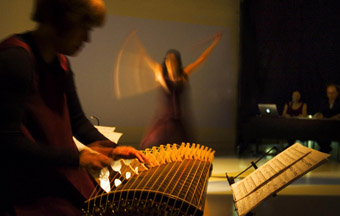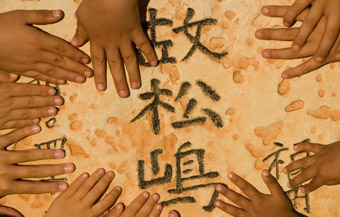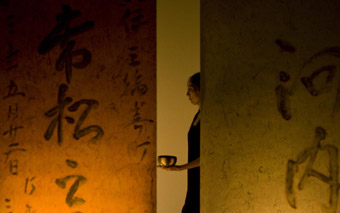dancing lightly on their graves
gail priest: in repose, japan foundation, sydney

Satsuki Odamura, Wakako Asano, Mayu Kanamori, Vic McEwan, In Repose
photo Jenny Evans
Satsuki Odamura, Wakako Asano, Mayu Kanamori, Vic McEwan, In Repose
PHOTOGRAPHER MAYU KANAMORI, DANCER WAKAKO ASANO AND KOTO PLAYER SATSUKI ODAMURA ARE JAPANESE-BORN ARTISTS WHO HAVE CHOSEN TO SPEND THEIR LIVES IN AUSTRALIA AND, EVENTUALLY, TO BE BURIED IN THIS ADOPTED HOMELAND. THEIR PROJECT IN REPOSE (ALSO WITH SOUND DESIGNER VIC MCEWAN) REPRESENTS AN ARTISTIC EXPLORATION OF WHAT THIS DECISION MEANS NOT ONLY TO THEMSELVES BUT ALSO TO THE MANY JAPANESE WHO HAVE PREVIOUSLY MIGRATED AND DIED HERE.
The In Repose project has been under way since 2007, with a range of performances, exhibitions and community workshops in Townsville, Broome, Thursday Island, Port Hedland, Roebourne and Cossack. In each the group performed a version of ‘kuyo,’ a ceremonial offering to honour the spirits of the dead. This involved lighting incense and pouring water on the graves to slake the thirst of the spirits, and in their contemporary adaptation also incorporated music and dance. In many places this ceremony was opened up to involve the local community while in other smaller locations the acts were more private.
The performance lecture, presented in 2010 amidst the photographic installation at the Japan Foundation, brings these outcomes together. Like Kanamori’s photographs—close-ups of the weathered texture of inscribed rocks, native grasses entangled with headstones—the performance, with the addition of music and dance, offers a more impressionistic retelling of events. It is not overladen with information, but rather offers fragments, anecdotes and space for reflection on the project.

Japanese Cemetery, Broome, In Repose
photo Mayu Kanamori
Japanese Cemetery, Broome, In Repose
What becomes quickly apparent is that there can be no discussion of the Japanese sense of ancestral spirituality without acknowledgement that the graves are on the lands of indigenous Australian peoples. It is the cultural exchange that takes place around this that makes the project particularly interesting. In Broome the connection is most obvious as many Japanese pearl divers married local Indigenous people. In Repose’s title image, taken in the Broome cemetery, shows small, honey-brown hands on a sand-coloured gravestone that Kanamori describes as the “the colour of the skin when Indigenous Australians have children with Japanese.”
On Thursday Island one of the workshop participants makes a short video discussing the local beliefs surrounding death and the passage of the spirit, which Kanamori tells us is particularly resonant with Japanese culture. In Port Hedland, visiting Japanese video artist Shigeaki Iwai wanders over the hill from the graveyard to discover the local Indigenous people. Initially they mistake his tripod for a gun, but then they get to talking and he asks if their ‘mob,’ can look after ‘our mob.’ In the small town of Roebourne, the team discover that the graves they’d been told about have been cleared to make way for housing for the local Indigenous residents. In an impromptu ritual, the team honours the dead, but also passes on the story to the local kids, so that this ‘new’ history may be added to the old history of the land.

Wakako Asano, In Repose
photo Jenny Evans
Wakako Asano, In Repose
The performance itself, is restrained and contemplative. McEwan joins Kanamori as a lecturer, offering the perspective of an Australian of Scottish origin, with gentle wit, and the small moments of banter between them loosen the formal lecture feel. Between the textual vignettes, Satsuki Odamura plays pieces commissioned for the project on koto and bass koto while Wakako Asano dances. There are some beautiful duets, atmospherically lit in the challenging gallery surrounds by Amber Silk. Asano works closely with the rhythmic complexities and ethereal harmonies of the music, and it is always a privilege to hear Odamura’s virtuosity on these wonderful instruments. However while these moments, sometimes accompanied by projected images, offered time for deep reflection there were perhaps a few too many for the structural balance of the work. Interestingly, most of the music was commissioned from western composers, and similarly Asano’s choreographic language is predominantly western contemporary. Initially I yearned for a more ‘Japanese’ dance-style, more earthed than the float and extension of the modern style, however the combination of western influences in both the music and the dance serve to illustrate the cultural duality that these artists have chosen in their move to Australia.
In Repose represents a very personal journey for the all the artists involved. It treads softly around the more contentious issues of colonisation, racial conflict and the White Australia Policy, instead highlighting the power of personal connection through the significant cultural and generational exchanges that took place within a range of communities. Through the retelling of these events it also opens up a space for the audience, rare in contemporary western culture, for our own reflection on death, spirituality, ancestry and a sense of homeland.
In Repose, photographer, storyteller Mayu Kanamori, koto player, sound Satsuki Odamura, dancer, choreographer Wakako Asano, sound design, storyteller Vic McEwan, lighting design Amber Silk, video Shigeaki Iwai, compositions Satsuki Odamura, Mark Isaacs, Rosalind Page, Michael Whiticker; Japan Foundation, Sydney, exhibition April 1-May14, performance April 10, May 1, May 13; http://www.mayu.com.au/folio/inrepose/; www.jpf.org.au
RealTime issue #96 April-May 2010 pg. web






